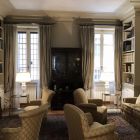Robben Island has a rich history, much of which is vital to South Africa’s identity.
The Island is located at the Table Bay, 6.9km west off the coast of Cape Town. It stands 30m over sea level and has been used, in the past, as a prison and as a place to isolate, banish and exile South African people for about 400 years.
The island was also used as a post office, grazing ground, a mental institution and as an outpost. Initially, the archipelago was home to an array of wildlife, such as birds, penguins, tortoises, and seals. The name "Robben" was derived from the Dutch word for seal.
Batolomeu Dias, a Portuguese explorer, discovered the island in 1488 when he landed his ship on Table Bay. As From 1671 the Dutch began to place their convicted criminals on the island. They also began to deport political prisoners from other Dutch colonies to the island.
The Dutch government imprisoned kings, princes and religious leaders from the East Indies to the isle, as they disagreed with the Dutch rule of their home country.
The British in 1806 annexed the Cape and continued the practice. In 1843 Colonial Secretary John Montagu advised a plan to use it as a colony for those suffering from leprosy, the mentally ill and those with chronic diseases. He put forth the suggestion to remove the penal colony and to send them to the mainland where they could be used for manual labour. His propositions were accepted and by 1845 the island had become a mental asylum for the British colony’s. The patients were often subjected to mistreatment, which was called cruel by the public. The conditions on the facility caused there to be many complaints from the progressive public, the clergy, and the medical staff.
After 1931, all the inhabitants were sent to hospitals in the Cape, and the island was used as a military outpost before World War 2. Guns were being stored there and the government build roads, a power station, and new water supplies and houses. However, in 1961 Robben Island began to be used as a prison once again. During the apartheid, many black people were being kept there as political prisoners.
From 1961 to 1991 the place was a maximum-security prison. Former President Nelson Mandela and other prominent black people who were a part of the South African anti-apartheid movement, like Govan Mbeki and Walter Sisulu were kept there. The prison was globally known to be notorious for its inhumane conditions.
Nelson Mandela’s cell was a seven by nine-foot room. He was held there for 18 years, from 1964. In Long Walk to Freedom, he wrote “I could walk the length of my cell in three paces. When I lay down, I could feel the wall with my feet and my head grazed the concrete at the other side”. In 1997, three years after the apartheid ended, the prison was turned to the Robben Island Museum. It is now a World Heritage Site.
In the present day, there are official tours that run from 9 a.m., 11 a.m., 1 p.m. and 3 p.m.
The ferries depart from the Nelson Mandela Gateway and the V & A Waterfront. The tour takes 3.5 hours, which includes the ferry trip to and from the destination. Tourists get down at Murray’s Bay Harbour, on the east coast of the island and take a bus that transports them to all the prominent sites. The tour guide will be present on the bus, who will be an official Robben Island Tour Guide. It includes the graveyard of the victims of leprosy, the Lime Quarry, Rober Sobukwe’s house, the Bluestone quarry, the army, and navy bunkers and the Maximum-Security Prison. The final destination will be Nelson Mandela's cell.
General Info
View on Map
Visiting Robben Island
Robben Island, South Africa













